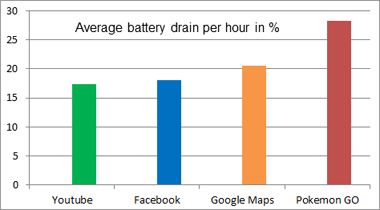A speaker at a battery conference once said that a battery in a mobile phone should last for several months between recharges to resemble a battery in a watch. In the 1990s, the runtime of mobile phones improved with batteries lasting up to a week and credit goes to digital technology, better networks and the Li-ion battery. Communication was by voice and SMS text only. With today’s power-robbing features such as touchscreen displays, GPS and graphics, manufacturers struggle to provide battery power of a day.
Pokémon GO throws all efforts to achieve low battery consumption out the window with a typical play time of only 4 hours. Folks embrace this location-based reality game as if to awaken our natural instinct to hunt. It’s unnatural for us to conquer vacuum-sealed packaged food in the coolers of supermarkets. Our bodies are created to master and kill, and now that we can slip a weapon in the form of a smartphone into our jeans, we venture out of our dwellings and do what our forefathers did ten-thousand years ago. The difference, however, is entering a fantasy world to pursue the Pokémon rather that hit real targets.
| Fictional imagination of a mobile phone goes back to the early 1900s when people envisioned talking by wireless connection over long distances. Handheld radio transceivers became available in the 1940’s, and in 1948 a science fiction novel called Space Cadet featured a character receiving a call on a pocket telephone. In 1958, another fiction writer envisioned a “personal transceiver so small and compact that every man carries one.” This device would be capable of calling any person on earth and include global positioning (GPS) so that “no one need ever again be lost.” The U.S. TV series Get Smart from 1965 to 1970 portrayed spy gadgets with mobile telephones concealed in random objects, including shoes. |  Investigator Get Smart |
Motorola was the first company to produce a handheld mobile phone. In 1973 a Motorola engineer made the first mobile telephone call from a handheld device to an engineer at Bell Labs, the co-inventor of the mobile phone. These early devices worked on analog technology, were barely portable and consumed high power from a battery that was heavy and held limited capacity. Furthermore, the networks were incompatible with other systems and had limited range.
The big break came with digital technology in the 1990s and the high-capacity Li-ion battery. Networks expanded and repeater towers grew like weeds on a lawn. Modern mobile phone today uses little power because the repeater towers are placed in close proximity to where we live. This increased the runtime, but there are exceptions, even before Pokémon GO arrived.
As the author of BatteryUniversity.com, I get many interesting questions. A battery user writes, “Hi, I am looking for an answer to a perplexing question. A co-worker and I have identical mobile phones from the same provider. Moving into a new house, she complained that her battery life has shortened. I told her that she was out of her mind, but then I noticed my battery behaving differently when I travel. Is there some mysterious force that’s draining the battery?”
The answer is, yes, there is a hidden force that drains the battery, but it’s not mystical. In standby mode, a mobile phone is in constant communication with the tower, transmitting small bursts of power every second or so to check for incoming calls. To save energy, the circuit adjusts the transmit power to a level that assures reliable communications. Being close to a repeater tower lowers the power; moving away or entering an area with high electrical noise, such as a shopping mall, hospital or factory, boosts the power. An analogy is raising your voice when talking in a noisy restaurant.
Living in sight of a tower has advantages in that the battery runs longer between charges. Where you place the mobile phone at home also affects the runtime. A manager of a large cellular provider in the UK said that his son experienced shorter standby times after moving from his upstairs bedroom to the basement bedroom. Modern office buildings with heat-reflecting glass panels also curtail reception. While coated glass reduces sun rays, it also shields RF and the mobile phone needs to work a bit harder.
If possible, leave your mobile phone in an upstairs room facing a tower. When traveling by car, place the phone near a window rather than on the floor, but avoid direct exposure to the sun. Turning the phone off or putting it in airplane mode reduces the battery drain to a trickle to maintain basic housekeeping functions, such as the clock.
The energy a battery can hold is measured in capacity. Capacity is the leading health indicator that sets the runtime and predicts the end of battery life. A new battery is rated at 100%, but the capacity fades with use. As a simple guideline, a battery in a mobile device with a capacity of 100% should provide a runtime of about 10 hours, 80% is 8 hours and 70%, 7 hours. The service life is limited to 300 and 500 discharge/ charge cycles before the capacity drops to 80%. It is better not to discharge Li-ion too deeply and to charge more often.
Pokémon Go stresses the battery more than other uses in requesting deep cycles prompted by long playtimes. The game requires almost constant communication with the towers to maintain internet connection. Other applications are typically shorter in duration. Figure 1 compares the average battery drain of typical smartphone applications with Pokémon Go.
 | Figure 1: Average battery drain per hour in percentage. The analysis is based on crowdsource data and users experience. Pokémon Go has one of the highest battery drain rate. The average battery level loss is 28% per hour. Courtesy P3 Group |
When walking, Google Map API constantly updates to correlate the data. This, together with other activities reduces the state-of-charge by about 5% every 10 minutes. The maker, Niantic, Inc., admits that the video game is not yet perfect, but improvements are being made. If the smartphone battery is not large enough or if it has faded and can no longer deliver the anticipated capacity, use an external battery pack to prolong the playing time.
Here are the major gas-guzzlers of your mobile phone that are running when playing Pokémon Go.
GPS: The global position system is always on during play. High battery drain is noticeable in the initial acquisition of the satellite’s navigation message to establish the coordinate. Mapping activities occurs between 3 and 4 satellites and this requires full processor (CPU) activity. The GPS continues to improve location precision. While other functions on a smartphone allow sleep modes to save the battery, GPS devours power all the time. The typical consumption of the GPS module is 150mW.
Display: The display is a power hog, especially if set to bright. The consumption on the lowest setting is about 8mW; the brightest exceeds 400mW. A frugal user uses a brightness that draws about 150mW in daylight; 75 inside.
Camera: The camera draws about 200mW and engages when capturing a Pokémon.
CPU: The CPU, RAM, graphics and other household activities (excluding GPS and the display backlight and camera) consume about 350mW.
GSM: The GSM module draws power by maintaining connection with the tower. Making a call raises the GSM to over 800mW, but Pokémon Go does not need to communicate to the tower.
Here are ways to save battery power.
- Close network-enable apps to avoid data usage
- Dim the brightness of the screen. Power consumption increases exponential with brightness
- Turn on battery saver. It will dim the display and decrease the refresh rate of the in-game map
- If not used, turn off Wi-Fi and Bluetooth .Disable sounds
- Download local maps of your city for offline use to play the game
- Turn off the AR Mode (AR Mode stands for augmented reality mode)
Pokémon GO is not only demanding on your smartphone, it also stresses the server. Within 24 hours after its release, the game became one of the most used video games ever released and the flood of data caused several servers to crash. In addition, hackers have made deliberate attempts to bring servers down.
Some medical professionals praise the game for improving the mental and physical health of the players; others expressed concerns of being a public nuisance and causing accidents. There are reported cases of crashing a car while chasing Pokémon and falling off a cliff by climbing a fence.
The first Pokémon game was released in 1996 on the Game Boy by Nintendo. Pokémon Go as we know it today was developed by Niantic Labs and published by The Pokémon Company, located in San Francisco. Formed in 2010, Niantic is an off-spring of Google and the company became independent in October 2015.
After releasing several location-based mobile apps since 2012, including Ingress, Niantic announced in September 2015 that it was developing Pokémon Go in partnership with Nintendo and The Pokémon Company. They invested $30 million and secured an additional $5 million from venture capital firms. Pokémon GO was released in July 2016 for iOS and Android systems in Australia, New Zealand, the USA, Canada and most of Europe.
Mr. Iwata of Nintendo and Mr. Ishihara of The Pokémon Company proposed the game in 2014 as part of an April Fool’s Day joke to Google. Ishihara was a fan of the Ingress game and saw a perfect match for the Pokémon series. The use of Ingress data for Pokémon Go many explain the short time to market.
After the release, investors became buoyed and the Nintendo stock in Tokyo went up by 86%. Planning to release four more smartphone app games by March 2017, Financial Times points to investor speculation because Nintendo possesses some of the “most valuable character intellectual property in the world.” The company had historically been promoting portable consoles and now they are recovering lost ground by co-sharing the runaway hit.
It is speculated that the game can catch criminals in the act and assist law enforcement. Businesses are contemplating to amass customers, but some residents are already fed up with the large number of players gathering at their once sacred grounds. The advantages are prevailing as the game brings together people from all walks of life to interact. Its social nature helps folks suffering from depression and social anxiety to interact with people of all backgrounds by doing something in common. We are social animals and players have reported increased motivation to exercise and improved mood by playing the game.
How long will Pokémon Go live? Will people play even in the cold of winter? Critics say that catching Pokémon in your own neighborhood puts a smile on the player’s face, but the longevity will depend on how well Niantic can improve the game and offer new features. It could last for years or end up like fireworks with wow-factor for a time, followed by burned-out shells littering the ground.
Pokémon Go is opening new dimensions for smartphones. Augmented reality has the power to go beyond catching a cute Pokémon monster. It may one day display menus in a restaurant with nutritional values, a map to get there, a bus stop and subway station with timetables, a free parking space, or even help in the dating process of a single adult. As these apps change our lives, they will also impose new demands on the devices we carry, not the least the battery with a decent runtime.
Reference:
An Analysis of Power Consumption in a Smartphone; Aaron Carroll, NICTA and University of New South Wales; Gernot Heiser, NICTA, University of New South Wales and Open Kernel Labs.
Survey: Techniques for Efficient energy consumption in Mobile Architectures; Sean Maloney and Ivan Boci, University of California, Santa Barbara;
P3 Group (technical consulting, management and engineering services company)
Wikipedia, BatteryUniversity.com, web resources and newspaper reports
About the Author
Isidor Buchmann is the founder and CEO of Cadex Electronics Inc. For three decades, Buchmann has studied the behavior of rechargeable batteries in practical, everyday applications, has written award-winning articles including the best-selling book “Batteries in a Portable World,” now in its third edition. Cadex specializes in the design and manufacturing of battery chargers, analyzers and monitoring devices. For more information on batteries, visit www.batteryuniversity.com; product information is on www.cadex.com.

Comments
Looking for comments from the previous website?
Comments from the previous website are not compatible with our new commenting system but we have preserved them so our users can still reference and make use the information in them.
